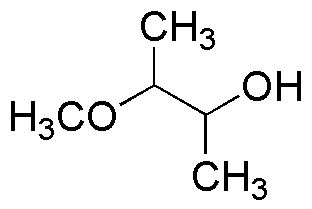3-Methoxy-2-butanol is widely utilized in research focused on:
- Solvent Applications: This compound serves as an effective solvent in various chemical reactions and formulations, particularly in the production of paints, coatings, and adhesives, enhancing their performance and stability.
- Pharmaceuticals: It is used as an intermediate in the synthesis of pharmaceutical compounds, providing a versatile building block for drug development, especially in the creation of complex organic molecules.
- Cosmetics and Personal Care: The compound is incorporated into cosmetic formulations for its ability to improve texture and stability, making products like lotions and creams feel smoother and more appealing to consumers.
- Flavor and Fragrance Industry: 3-Methoxy-2-butanol is utilized in the production of flavoring agents and fragrances, contributing to the formulation of various food products and perfumes with desirable scent profiles.
- Research and Development: In academic and industrial labs, it is often employed in synthetic organic chemistry experiments, aiding researchers in exploring new chemical reactions and pathways due to its unique properties.
General Information
Properties
Safety and Regulations
Applications
3-Methoxy-2-butanol is widely utilized in research focused on:
- Solvent Applications: This compound serves as an effective solvent in various chemical reactions and formulations, particularly in the production of paints, coatings, and adhesives, enhancing their performance and stability.
- Pharmaceuticals: It is used as an intermediate in the synthesis of pharmaceutical compounds, providing a versatile building block for drug development, especially in the creation of complex organic molecules.
- Cosmetics and Personal Care: The compound is incorporated into cosmetic formulations for its ability to improve texture and stability, making products like lotions and creams feel smoother and more appealing to consumers.
- Flavor and Fragrance Industry: 3-Methoxy-2-butanol is utilized in the production of flavoring agents and fragrances, contributing to the formulation of various food products and perfumes with desirable scent profiles.
- Research and Development: In academic and industrial labs, it is often employed in synthetic organic chemistry experiments, aiding researchers in exploring new chemical reactions and pathways due to its unique properties.
Documents
Safety Data Sheets (SDS)
The SDS provides comprehensive safety information on handling, storage, and disposal of the product.
Product Specification (PS)
The PS provides a comprehensive breakdown of the product’s properties, including chemical composition, physical state, purity, and storage requirements. It also details acceptable quality ranges and the product's intended applications.
Certificates of Analysis (COA)
Search for Certificates of Analysis (COA) by entering the products Lot Number. Lot and Batch Numbers can be found on a product’s label following the words ‘Lot’ or ‘Batch’.
Numéro de catalogue
Numéro de lot/série
Certificates Of Origin (COO)
This COO confirms the country where the product was manufactured, and also details the materials and components used in it and whether it is derived from natural, synthetic, or other specific sources. This certificate may be required for customs, trade, and regulatory compliance.
Numéro de catalogue
Numéro de lot/série
Safety Data Sheets (SDS)
The SDS provides comprehensive safety information on handling, storage, and disposal of the product.
DownloadProduct Specification (PS)
The PS provides a comprehensive breakdown of the product’s properties, including chemical composition, physical state, purity, and storage requirements. It also details acceptable quality ranges and the product's intended applications.
DownloadCertificates of Analysis (COA)
Search for Certificates of Analysis (COA) by entering the products Lot Number. Lot and Batch Numbers can be found on a product’s label following the words ‘Lot’ or ‘Batch’.
Numéro de catalogue
Numéro de lot/série
Certificates Of Origin (COO)
This COO confirms the country where the product was manufactured, and also details the materials and components used in it and whether it is derived from natural, synthetic, or other specific sources. This certificate may be required for customs, trade, and regulatory compliance.


